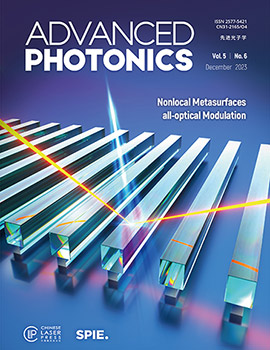光学涡旋的非衍射偏振特性
IF 18.8
1区 物理与天体物理
Q1 OPTICS
引用次数: 0
摘要
近年来,光学涡旋在光学操纵、轨道角动量、光学模式复用和量子信息等方面的应用得到了广泛的研究。当偏振(自旋角动量)遇到光学涡旋的相位奇异性(轨道角动量)时,就会发生自旋-轨道相互作用,从而发现更迷人的特征,如光学skyrmions和偏振稳健性。光学涡旋就像一座丰富的金矿,还有许多更迷人的特征有待揭示。最近,美国乔治华盛顿大学的Andrei Afanasev与英国伦敦国王学院的Anatoly V.Zayats研究小组合作,在Advanced Photonics Nexus上通过理论分析和模拟证明,涡旋光束的某些偏振特性保持恒定的横向空间维度,与光束衍射无关。这些极化特征出现在相位奇点附近,并且与纵向电场的存在有关。传统上,对非衍射光束的研究主要集中在它们的强度分布上,这使它们能够在自由空间中传播,而不会在远远超过正常瑞利长度的距离上显著扩展。这种光束的例子包括无衍射贝塞尔光束和艾里光束。通常,这些非衍射光束源于对麦克斯韦自由空间波动方程的包状解的追求,导致非衍射特征局限于电磁场或能量流的强度,而偏振特性被忽略。然而,当考虑偏振时,这些光束的非衍射特性仍然伴随着强度发散。换句话说,当强度是衍射的时,偏振也是衍射的。A.Afanasev和A.V.Zayats在他们的报告中,从理论和数值上证明了光学涡旋光束的部分偏振特征的横向尺寸不受光束衍射的影响(见图1)。这种显著的影响归因于矢量涡旋中纵向和横向电磁场的相互作用导致的光束截面的相位奇异性。利用傍轴简化分析模型和非傍轴数值模拟,分析了涡旋光束三维偏振中的非衍射行为。值得注意的是,涡流束的纵向场不能被忽视,因为它可能会影响模拟研究的准确性。三维涡流场中纵向场的存在使得传统的斯托克斯参数二维偏振描述不完整。因此,作者采用了自旋1粒子极化的常规描述,其中包括自旋矢量和四极张量的矩阵。通常,需要py、pzz和pxx-py参数来完全描述高度发散的紧密聚焦光束中的偏振结构。作者研究了紧聚焦光学涡旋光束在奇异点附近相对于入射线性和圆形偏振的三维偏振参数。他们证明了偏振结构保持不变,并延伸到焦平面之外。此外,作者通过数值模拟证实,聚焦系统的数值孔径和实际实验中的缺陷光束或像差不会影响这些偏振特征的非衍射性质。预测的非衍射偏振特征具有相对较小的横向尺寸,在低l波长的一小部分数量级,并且集中在光学涡旋波前的低强度区域上。因此,精确测量需要高分辨率和高灵敏度。这项工作代表着朝着充分理解光学涡旋偏振特征的非衍射性质和研究自旋-轨道相互作用的内在性质迈出了重要一步。在应用方面,该研究为光学计量、光学通信、光学网络、激光传感和雷达操作提供了新的视角。此外,研究这些非衍射的3D偏振特征可以有利于光子准粒子和时空光学涡旋等领域的研究。本文章由计算机程序翻译,如有差异,请以英文原文为准。
Nondiffractive polarization feature of optical vortices
Optical vortices have been extensively researched in recent years for applications in optical manipulation, orbital angular momentum, optical mode multiplexing, and quantum information. When the polarizations (spin angular momentum) encounter the phase singularity (orbital angular momentum) of an optical vortex, spin-orbit interaction occurs, leading to the discovery of even more fascinating features such as optical skyrmions and polarization robustness. Optical vortices are like a rich goldmine with many more fascinating features yet to be revealed. Recently, in Advanced Photonics Nexus, Andrei Afanasev from GeorgeWashington University, USA, in collaboration with the research group of Anatoly V. Zayats from King’s College London, UK, demonstrated through theoretical analysis and simulation that certain polarization features of vortex beams maintain constant transverse spatial dimensions, independent of beam diffraction. These polarization features appear near phase singularities and are related to the presence of longitudinal electric fields. Traditionally, research on nondiffracting beams has mainly focused on their intensity distributions, which enable them to travel in free space without significant spreading over distances far exceeding the normal Rayleigh length. Examples of such beams include the nondiffracting Bessel beam and Airy beam. Typically, these nondiffracting beams originated from the pursuit of packet-like solutions to Maxwell’s free space wave equation, resulting in nondiffractive features limited to the intensity of the electromagnetic fields or the energy flow, with polarization properties being neglected. However, when polarization is taken into consideration, the nondiffractive character is still accompanied by intensity divergence of these beams. In other words, when intensity is diffractive, polarization is also diffractive. In their report, A. Afanasev and A. V. Zayats demonstrate, both theoretically and numerically, that the transverse dimension of the partial polarization feature of an optical vortex beam remains unaffected by beam diffraction (see Fig. 1). This remarkable effect is attributed to the phase singularity of the beam cross-section, resulting from the interaction of the longitudinal and transverse electromagnetic fields in the vector vortex. The nondiffraction behavior in the three-dimensional polarization of vortex beams is analyzed using a paraxial simplified analytical model and nonparaxial numerical simulation. It is important to note that the longitudinal field of the vortex beam cannot be ignored, as it may affect the accuracy of the simulation study. The existence of the longitudinal field in a 3D vortex field makes the conventional 2D polarization description of Stokes parameters incomplete. Therefore, the authors have adopted the convention description of polarization for spin-1 particles, which includes matrices of the spin vector and the quadrupolar tensor. Typically, the py, pzz, and pxx-pyy parameters are required to fully describe the polarization structure in a tightly focusing beam that is highly divergent. The authors investigated the 3D polarization parameters near the singularity of a tightly focused optical vortex beam with respect to the incident linear and circular polarizations. They demonstrated that the polarization structures remain invariant and extend far beyond the focal plane. Additionally, the authors confirmed through numerical simulations that the numerical aperture of the focusing system and the imperfections beam or aberrations in the actual experiment will not affect the non-diffractive nature of these polarization features. The predicted nondiffractive polarization features have relatively small transverse dimensions, on the order of a fraction of a wavelength at low l, and are centered on a low-intensity region of the optical vortex wavefront. As a result, high resolution and sensitivity are required for accurate measurement. This work represents an important step towards fully understanding the nondiffractive nature of optical vortex polarization features and investigating the intrinsic nature of spin-orbital interaction. In terms of applications, the study sheds new light on optical metrology, optical communications, optical networking, laser sensing, and radar operations. Additionally, investigating these nondiffractive 3D polarization features can benefit research in photonic quasiparticles and spatiotemporal optical vortices, among other areas.
求助全文
通过发布文献求助,成功后即可免费获取论文全文。
去求助
来源期刊

Advanced Photonics
OPTICS-
CiteScore
22.70
自引率
1.20%
发文量
49
审稿时长
18 weeks
期刊介绍:
Advanced Photonics is a highly selective, open-access, international journal that publishes innovative research in all areas of optics and photonics, including fundamental and applied research. The journal publishes top-quality original papers, letters, and review articles, reflecting significant advances and breakthroughs in theoretical and experimental research and novel applications with considerable potential.
The journal seeks high-quality, high-impact articles across the entire spectrum of optics, photonics, and related fields with specific emphasis on the following acceptance criteria:
-New concepts in terms of fundamental research with great impact and significance
-State-of-the-art technologies in terms of novel methods for important applications
-Reviews of recent major advances and discoveries and state-of-the-art benchmarking.
The journal also publishes news and commentaries highlighting scientific and technological discoveries, breakthroughs, and achievements in optics, photonics, and related fields.
 求助内容:
求助内容: 应助结果提醒方式:
应助结果提醒方式:


